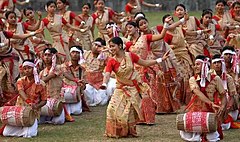
Back বিহু Assamese बिहू Bihari বিহু Bengali/Bangla বিহু BPY Bihu Spanish Bihu Finnish Bihu French बिहु त्योहार Hindi ಬಿಹು Kannada ബിഹു Malayalam
| Bihu | |
|---|---|
 Bihu of Assam | |
| Official name | Bihu |
| Also called | Rongali Bihu, Kati Bihu, Bhogali Bihu Bhogali Bihu |
| Observed by | People of Assam |
| Type | Regional folk |
| Ends | Varies |
| Frequency | Tri-annual |
| Related to | Bushu of Dimasas |
| Part of a series on the |
| Culture of Assam |
|---|
 |
Bihu is of three types and it is an important cultural festival unique to the Indian state of Assam[4] – 'Rongali' or 'Bohag Bihu' observed in April, 'Kongali' or 'Kati Bihu' observed in October or November, and 'Bhogali' or 'Magh Bihu' observed in January.[5] The festivals present an admixture of Tibeto-Barman, Austroasiatic and Indo-Aryan traditions entwined so intricately that it is impossible to separate them[6]—festivals which are uniquely Assamese to which all communities of Assam had contributed elements.[7] The Rongali Bihu is the most important of the three, celebrating spring festival. The Bhogali Bihu or the Magh Bihu is a harvest festival, with community feasts. The Kongali Bihu or the Kati Bihu is the sombre, thrifty one reflecting a season of short supplies and is an animistic festival.[8]
The Rongali Bihu coincides with the Assamese New Year and as well as with other regions of Indian subcontinent, East Asia and South-East Asia, which follow the Hindu calendar and Buddhist calendar.[9] The other two Bihu festivals every year are unique to Assamese people. Like some other Indian festivals, Bihu is associated with agriculture, and rice in particular. Bohag Bihu is a sowing festival, Kati Bihu is associated with crop protection and worship of plants and crops and is an animistic form of the festival, while Bhogali Bihu is a harvest festival.[10][11] Assamese celebrate the Rongali Bihu with feasts, music and dancing. Some hang brass, copper or silver pots on poles in front of their house, while children wear flower garlands then greet the new year as they pass through the rural streets.[12]
The three Bihu are Assamese festivals[12] elders in family, fertility and mother goddess, but the celebrations and rituals reflect influences from Southeast Asia and Sino-Tibetan cultures.[13][14][15] In contemporary times, the Bihus are celebrated by all Assamese people irrespective of religion, caste or creed.[16] It is also celebrated overseas by the Assamese diaspora community living worldwide.
The term Bihu is also used to imply Bihu dance otherwise called Bihu Naas and Bihu folk songs also called Bihu Geet.
- ^ "639 Identifier Documentation: aho – ISO 639-3". SIL International (formerly known as the Summer Institute of Linguistics). SIL International. Retrieved 29 June 2019.
Ahom [aho]
- ^ "Population by Religious Communities". Census India – 2001. Ministry of Home Affairs, Government of India. Retrieved 1 July 2019.
Census Data Finder/C Series/Population by Religious Communities
- ^ "Population by religion community – 2011". Census of India, 2011. The Registrar General & Census Commissioner, India. Archived from the original on 25 August 2015.
2011census/C-01/DDW00C-01 MDDS.XLS
- ^ "However, the festival to which utmost social importance is assigned by the people is Bihu, a festival that is neither pan-Indian in character nor observed with any religious fervour." (Barua 2009:213)
- ^ Roshen Dalal (2010). Hinduism: An Alphabetical Guide. Penguin Books. p. 136. ISBN 978-0-14-341421-6.
- ^ "As folklorist Lila Gogoi (1988: 1) points out, Aryan, Austric, Mongolian, and Alpine elements are so closely intertwined in the Bihu festival that it is almost impossible to separate them analytically. Celebrated by almost all the communities of Assam, it is inspired by the seasonal changes and the commensurately changing agricultural cycles." (Goswami 2014:61)
- ^ "Bihu was born as a uniquely Axomiya festival, to which almost every community of Assam could claim to have lent some elements, but none could assert sole ownership." (Goswami 2014:61)
- ^ Sunita Pant Bansal (2005). Encyclopaedia of India. Smriti Books. p. 67. ISBN 978-81-87967-71-2.
- ^ Praphulladatta Goswami (1966). The springtime bihu of Assam: a socio-cultural study. Guwahati. OCLC 474819.
- ^ S. D. Sharma (2010). Rice: Origin, Antiquity and History. CRC Press. pp. 56, 60–61. ISBN 978-1-4398-4056-6.
- ^ Goswami, Praphulladatta (1967). "Hindu and Tribal Folklore in Assam". Asian Folklore Studies. 26 (1). JSTOR: 19–27. doi:10.2307/1177697. JSTOR 1177697.
- ^ a b Christian Roy (2005). Traditional Festivals: A Multicultural Encyclopedia. ABC-CLIO. pp. 479–480. ISBN 978-1-57607-089-5.
- ^ Roshen Dalal (2010). Hinduism: An Alphabetical Guide. Penguin Books. p. 76. ISBN 978-0-14-341421-6.
- ^ Uddipana Goswami (2014). Conflict and Reconciliation: The Politics of Ethnicity in Assam. Routledge. pp. 61–63. ISBN 978-1-317-55997-9.
- ^ Amaresh Datta (1988). Encyclopaedia of Indian Literature. Sahitya Akademi. pp. 1277–1278. ISBN 978-81-260-1194-0.
- ^ "Culture of Assam - Government Of Assam, India". Archived from the original on 25 May 2016. Retrieved 8 June 2016.
© MMXXIII Rich X Search. We shall prevail. All rights reserved. Rich X Search